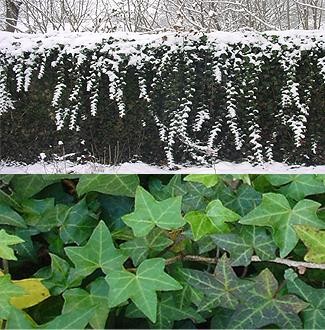Hedera helix |
| PlantFile Report |
Copyright © 2000 - 2025 Peter Kirkland - www.plantfile.com |
Plant Profile |
|
| Plant |
| ID |
|
55 |
 |
| Botanic Name |
|
Hedera helix |
| Common Name |
|
English Ivy, Common Ivy |
| Family Name |
|
Araliaceae |
| Cultivars |
|
'Atropurpurea','Baltica','Buttercup','Erecta','Glacier','Goldheart','Iva lace','Manda' s Crested','Pedata','Pittsburg','Silver Queen','Argenteo - variegata','Conglomerata','Cristata','Gold Dust','Marmorata','Trycolor' |
| Origin |
|
Central Europe, Zone 5-11 |
| Growth Type |
|
Climber |
| Bark Type |
|
Woody |
| Foliage Type |
|
Evergreen |
Water Use |
|
Low |
| No. of Species |
|
10 |
| Growth Habit |
|
Climbing-twining |
Growth Rate |
|
Fast |
| Height |
|
4 - 20 m (13 - 67 ft) |
Spread |
|
15 m (50 ft) |
| Plant Overview |
|
This vigorous climber has woody stems with adventitious rootlets that adhere to walls and structures forming a dense cover. It has juvenile and adult lobed dark glossy green leaves and the small greenish flowers are followed by black berries. |
|
| Leaf |
| Type |
|
Simple |
|
Additional Information |
| Shape |
|
Broad ovate |
|
The juvenile leaves are broad-ovate with 3 to 5 triangular lobes, and are up to 100 mm (4 in) long and wide with a cordate base. The apex is acute; petiole is long and the leaves are arranged densely along the stems. |
| Arrangement |
|
Alternate |
| Margin |
|
Entire |
| Colour |
|
Glossy dark green |
| Size |
|
80 - 100 mm ( 3.1 - 3.9 in ) |
|
| Flower |
| Perfume |
|
Odorless |
|
Additional Information |
| Shape |
|
Apetalous |
|
The small 5-tepaled flowers are inconspicuous and appearing on adult growth normally in the 8th to 10th year on a branched flower stem and are arranged in a terminal umbel that appears during late summer. |
| Inflorescence |
|
Umbel |
| Colour |
|
Yellow - green |
| Size |
|
4 - 6 mm ( 0.2 - 0.2 in ) |
|
Flowering in (Southern Hemisphere)
|
|
| Jan |
Feb |
Mar |
Apr |
May |
Jun |
| Jul |
Aug |
Sep |
Oct |
Nov |
Dec |
|
|
| Fruit |
| Type |
|
Drupe |
|
Additional Information |
| Colour |
|
Blue - black |
|
The blue-black berry-like fruit are produced on adult foliage and ripen the following year. They have a bitter taste and are poisonous. The small seeds are viable but the plant is commonly reproduced vegetatively to maintain true to type. |
| Edible |
|
No |
| Bird Attractive |
|
No |
| Size |
|
5 - 8 mm ( 0.2 - 0.3 in ) |
|
Fruiting in (Southern Hemisphere)
|
|
| Jan |
Feb |
Mar |
Apr |
May |
Jun |
| Jul |
Aug |
Sep |
Oct |
Nov |
Dec |
|
|
| Environment & Cultivation |
| Natural Soil |
|
Most soils, high organic well aerated clay to sandy loam, tending alkaline |
| Container |
|
Totem poles, hanging baskets, window boxes, pots |
| Climate |
|
Cold - cool temperate |
| Aspect |
|
Full sun, prefers part shade, frost and drought tolerant |
| Pest & Diseases |
|
Scale, caterpillars, aphids, sooty mold, cyclamen & spider mite, canker |
| Fertiliser |
|
During establishment, complete fertiliser in growing period, mulch with organic matter |
| Pruning |
|
As necessary to contain, tolerates a hard prune, remove adult growth |
| Cultural Uses |
|
Propagation |
|
English Ivy is grown for its foliage and dense spreading cover. It is grown as a ground cover or used to cover walls and may form a hedge over structures. It is also used for topiary and grown in containers. It establishes in 1 to 2 years.
|
|
Take soft tip or semi hardwood cuttings with aerial roots during the growing period. |
|
|